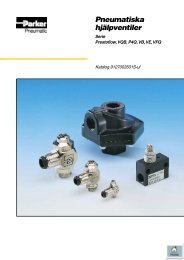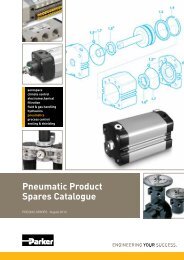Atlas Copco air motors - IAG
Atlas Copco air motors - IAG
Atlas Copco air motors - IAG
You also want an ePaper? Increase the reach of your titles
YUMPU automatically turns print PDFs into web optimized ePapers that Google loves.
Installing your <strong>air</strong><br />
motor<br />
Airlines<br />
The recommended dimensions of <strong>air</strong>lines is given in the introductory<br />
section to each motor type. Note that exhaust hose is larger than<br />
the inlet hose.<br />
The recommendations are valid for hose lengths of up to 3 metres.<br />
For distances between 3 and 15 metres select a hose diameter one<br />
size up, and for distances between 15 and 50 metres select a hose<br />
diameter two sizes up.<br />
It is important to note that the output of the motor will be reduced<br />
if these guidelines are not followed.<br />
Recommended hose connectors<br />
Because of the compact dimensions of the <strong>Atlas</strong> <strong>Copco</strong> vane<br />
<strong>motors</strong>, special hose connectors are available with small key width<br />
– facilitating easy installation. Table 8.<br />
The hose connectors below can be ordered through your local <strong>Atlas</strong><br />
<strong>Copco</strong> representative.<br />
Air preparation<br />
To ensure reliable service an <strong>air</strong> filter and lubricator should be fitted<br />
into the inlet <strong>air</strong>line – within 5 metres from the motor.<br />
It is recommended that a pressure regulator is also incorporated into<br />
the <strong>air</strong> preparation package. This has the function of maintaining<br />
the desired working pressure, and can be used to modify the<br />
motor’s output to meet the needs of the application.<br />
When selecting an <strong>air</strong> preparation package, ensure all components<br />
have a flow capacity sufficient to meet the requirements of the<br />
motor. A typical arrangement of an <strong>air</strong> preparation installation is<br />
shown below, Figure 32.<br />
Lubrication<br />
<strong>Atlas</strong> <strong>Copco</strong> <strong>air</strong> <strong>motors</strong> LZB 14, 22 and LZB 33/34 are available as<br />
standard in lubricated free versions. To achieve optimum service<br />
life and performance of the lubricated <strong>air</strong><strong>motors</strong> they should be supplied<br />
with 50 mm 3 of oil for each cubic metre (1000 litres) of <strong>air</strong><br />
consumed (1 drop = 15 mm 3 ).<br />
Insufficient lubrication will result in accelerated vane wear and a<br />
reduction in performance.<br />
The following example shows how to calculate the lubrication<br />
required by a motor running at a known output.<br />
Example:<br />
A non-reversible LZB 42 motor running at maximum output consumes<br />
13 litres/sec of <strong>air</strong>.<br />
In one minute it consumes 780 litres of <strong>air</strong>, therefore the lubrication required<br />
is:<br />
780 x 50 = 39 mm 3 /min<br />
1000<br />
If an oil-fog lubricator was to be used it should be set to deliver 3 drops of<br />
oil a minute<br />
(1 drop = 15 mm 3<br />
).<br />
The lubrication oil selected should have a viscosity which lies between<br />
50 and 300 x 10 6 m 2 /s at the motor’s working temperature.<br />
However, if it is necessary to reduce the level of oil exhauset from<br />
the motor, and a piped-away or filtered exhaust is not acceptable,<br />
then the lubrication level can be reduced.<br />
Although this will effect the motor, the performance may still be<br />
acceptable. Table 9 shows how reduced lubrication can affect service<br />
life and output.<br />
It is also possible to fit lubrication free vanes to other <strong>air</strong> <strong>motors</strong><br />
than LZB 14, 22 and LZB 33. However, that is only suitable under<br />
certain conditions. Check with your local <strong>Atlas</strong> <strong>Copco</strong> representative<br />
if you require further information.<br />
If the supply <strong>air</strong> is very dry the idling speed of the lubrication free<br />
<strong>motors</strong> may degrade somewhat after running for longer periods, a<br />
decrease of 10–15% may be noticeable. The power of the <strong>motors</strong> is,<br />
however, generally not affected. To guarantee longer service intervals<br />
the lubricated, standard <strong>motors</strong> are still the best choice.<br />
Thread in Hose size Ordering No. Thread in Hose size Ordering No.<br />
(in) (mm) (in) (in) (mm) (in)<br />
1/8 BSP 3.2 1/8 9000 0523 00 3/8 BPST 10.0 3/8 9000 0242 00<br />
1/8 BSP 5.0 3/16 4010 0031 00 3/8 BSPT 12.5 1/2 9000 0248 00<br />
1/8 BSPT 6.3 1/4 9000 0240 00 1/2 BSPT 12.5 1/2 9000 0243 00<br />
1/4 BSP 3.2 1/8 9000 0525 00 1/2 BSPT 16.0 5/8 9000 0244 00<br />
1/4 BSPT 6.3 1/4 9000 0241 00 1/2 BSPT 20.0 3/4 4150 0429 00<br />
1/4 BSPT 8.0 5/16 9090 1715 00 3/4 BSPT 20.0 3/4 9000 0245 00<br />
1/4 BSPT 10.0 3/8 9000 0247 00 1 BSPT 25.0 1 9000 0246 00<br />
Table 8<br />
A = filter<br />
B = Pressure regulator<br />
C = Oil fog lubricatior<br />
72 ATLAS COPCO AIRMOTORS 2002<br />
Figure 32<br />
Lubricant Service Output<br />
quantity life power<br />
(mm3 oil m3 ) (hours) (%)<br />
50 1000–3000 100<br />
10 500–1000 100<br />
1 200–500 90<br />
0.1 100–300 80<br />
0 10–30 30<br />
1 drop of oil is appr. 15 mm3 Table 9




